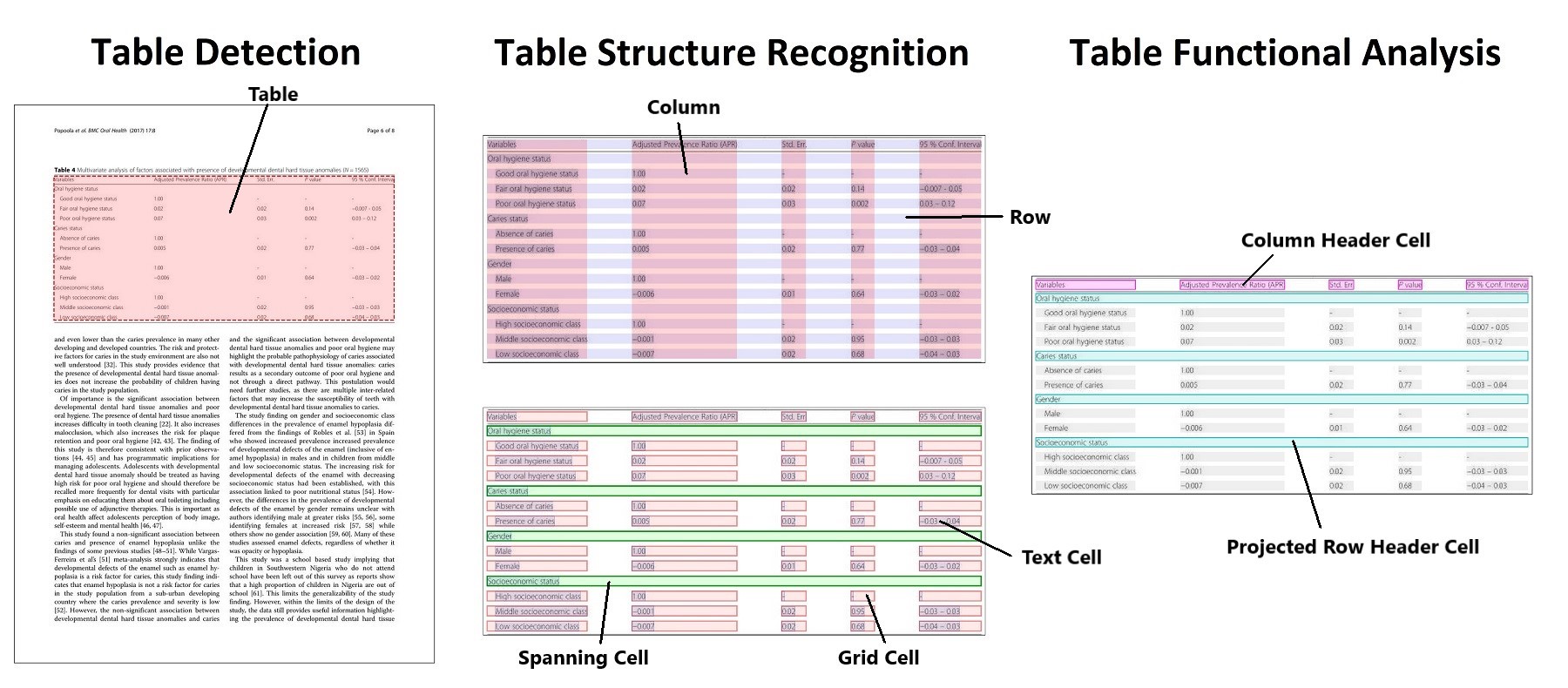This repository contains code and links to data for the papers:
- "PubTables-1M: Towards comprehensive table extraction from unstructured documents"
- "GriTS: Grid table similarity metric for table structure recognition" (coming soon)
Note: Updates to the code and papers (and documentation) are currently ongoing and we will announce when each of these is ready for a stable release.
The goal of PubTables-1M is to create a large, detailed, high-quality dataset for training and evaluating a wide variety of models for the tasks of table detection, table structure recognition, and functional analysis.
It contains:
- 460,589 annotated document pages containing tables for table detection.
- 947,642 fully annotated tables including text content and complete location (bounding box) information for table structure recognition and functional analysis.
- Full bounding boxes in both image and PDF coordinates for all table rows, columns, and cells (including blank cells), as well as other annotated structures such as column headers and projected row headers.
- Rendered images of all tables and pages.
- Bounding boxes and text for all words appearing in each table and page image.
- Additional cell properties not used in the current model training.
Additionally, cells in the headers are canonicalized and we implement multiple quality control steps to ensure the annotations are as free of noise as possible. For more details, please see our paper.
03/04/2022: We have released the pre-trained weights for the table detection model trained on PubTables-1M.
03/03/2022: "PubTables-1M: Towards comprehensive table extraction from unstructured documents" has been accepted at CVPR 2022.
11/21/2021: Our paper "PubTables-1M: Towards comprehensive table extraction from unstructured documents" is available on arXiv.
10/21/2021: The full PubTables-1M dataset has been officially released on Microsoft Research Open Data.
We provide the pre-trained model for table detection trained for 20 epochs on PubTables-1M.
| Task | Backbone | Schedule | AP50 | AP75 | AP | AR | File | Size |
|---|---|---|---|---|---|---|---|---|
| Table Detection | R18 | 20 Epochs | 0.995 | 0.989 | 0.970 | 0.985 | Weights | 110 MB |
PubTables-1M is available for download from Microsoft Research Open Data.
It comes in 5 tar.gz files:
- PubTables-1M-Image_Page_Detection_PASCAL_VOC.tar.gz
- PubTables-1M-Image_Page_Words_JSON.tar.gz
- PubTables-1M-Image_Table_Structure_PASCAL_VOC.tar.gz
- PubTables-1M-Image_Table_Words_JSON.tar.gz
- PubTables-1M-PDF_Annotations_JSON.tar.gz
To download from the command line:
- Visit the dataset home page with a web browser and click Download in the top left corner. This will create a link to download the dataset from Azure with a unique access token for you that looks like
https://msropendataset01.blob.core.windows.net/pubtables1m?[SAS_TOKEN_HERE]. - You can then use the command line tool azcopy to download all of the files with the following command:
azcopy copy "https://msropendataset01.blob.core.windows.net/pubtables1m?[SAS_TOKEN_HERE]" "/path/to/your/download/folder/" --recursive
Then unzip each of the archives from the command line using:
tar -xzvf yourfile.tar.gz
Create a conda environment from the yml file and activate it as follows
conda env create -f environment.yml
conda activate tables-detr
The code trains models for 2 different sets of table extraction tasks:
- Table Detection
- Table Structure Recognition + Functional Analysis
For a detailed description of these tasks and the models, please refer to the paper.
To train, you need to cd to the src directory and specify: 1. the path to the dataset, 2. the task (detection or structure), and 3. the path to the config file, which contains the hyperparameters for the architecture and training.
To train the detection model:
python main.py --data_type detection --config_file detection_config.json --data_root_dir /path/to/detection_data
To train the structure recognition model:
python main.py --data_type structure --config_file structure_config.json --data_root_dir /path/to/structure_data
Evaluation on the test data currently operates in two different modes. The first mode ("eval") computes standard metrics for object detection (AP, AP50, etc.). This mode applies to either the detection model or the structure recognition model.
The second mode ("grits") computes the grid table similarity (GriTS) metrics for table structure recognition. GriTS is a measure of table cell correctness and is defined as the average correctness of each cell averaged over all tables. GriTS can measure the correctness of predicted cells based on: 1. cell topology alone, 2. cell topology and the reported bounding box location of each cell, or 3. cell topology and the reported text content of each cell. For more details on GriTS, please see our papers.
To compute object detection metrics for the detection model:
python main.py --mode eval --data_type detection --config_file detection_config.json --data_root_dir /path/to/detection_data --model_load_path /path/to/detection_model
To compute object detection metrics for the structure recognition model:
python main.py --mode eval --data_type structure --config_file structure_config.json --data_root_dir /path/to/structure_data --model_load_path /path/to/structure_model
To compute the GriTS metrics for the structure recognition model:
python main.py --mode grits --data_type structure --config_file structure_config.json --data_root_dir /path/to/structure_data --table_words_dir /path/to/table_words_data --model_load_path /path/to/structure_model --metrics_save_filepath /path/to/metrics_log_file
Detailed instance-level metrics for GriTS are saved to the log file specified in --metrics_save_filepath.
Our work can be cited using:
@article{smock2021pubtables1m,
author={Smock, Brandon and Pesala, Rohith and Abraham, Robin},
title={Pub{T}ables-1{M}: Towards comprehensive table extraction from unstructured documents},
journal={arXiv preprint arXiv:2110.00061},
year={2021}
}
This project welcomes contributions and suggestions. Most contributions require you to agree to a Contributor License Agreement (CLA) declaring that you have the right to, and actually do, grant us the rights to use your contribution. For details, visit https://cla.opensource.microsoft.com.
When you submit a pull request, a CLA bot will automatically determine whether you need to provide a CLA and decorate the PR appropriately (e.g., status check, comment). Simply follow the instructions provided by the bot. You will only need to do this once across all repos using our CLA.
This project has adopted the Microsoft Open Source Code of Conduct. For more information see the Code of Conduct FAQ or contact [email protected] with any additional questions or comments.
This project may contain trademarks or logos for projects, products, or services. Authorized use of Microsoft trademarks or logos is subject to and must follow Microsoft's Trademark & Brand Guidelines. Use of Microsoft trademarks or logos in modified versions of this project must not cause confusion or imply Microsoft sponsorship. Any use of third-party trademarks or logos are subject to those third-party's policies.

